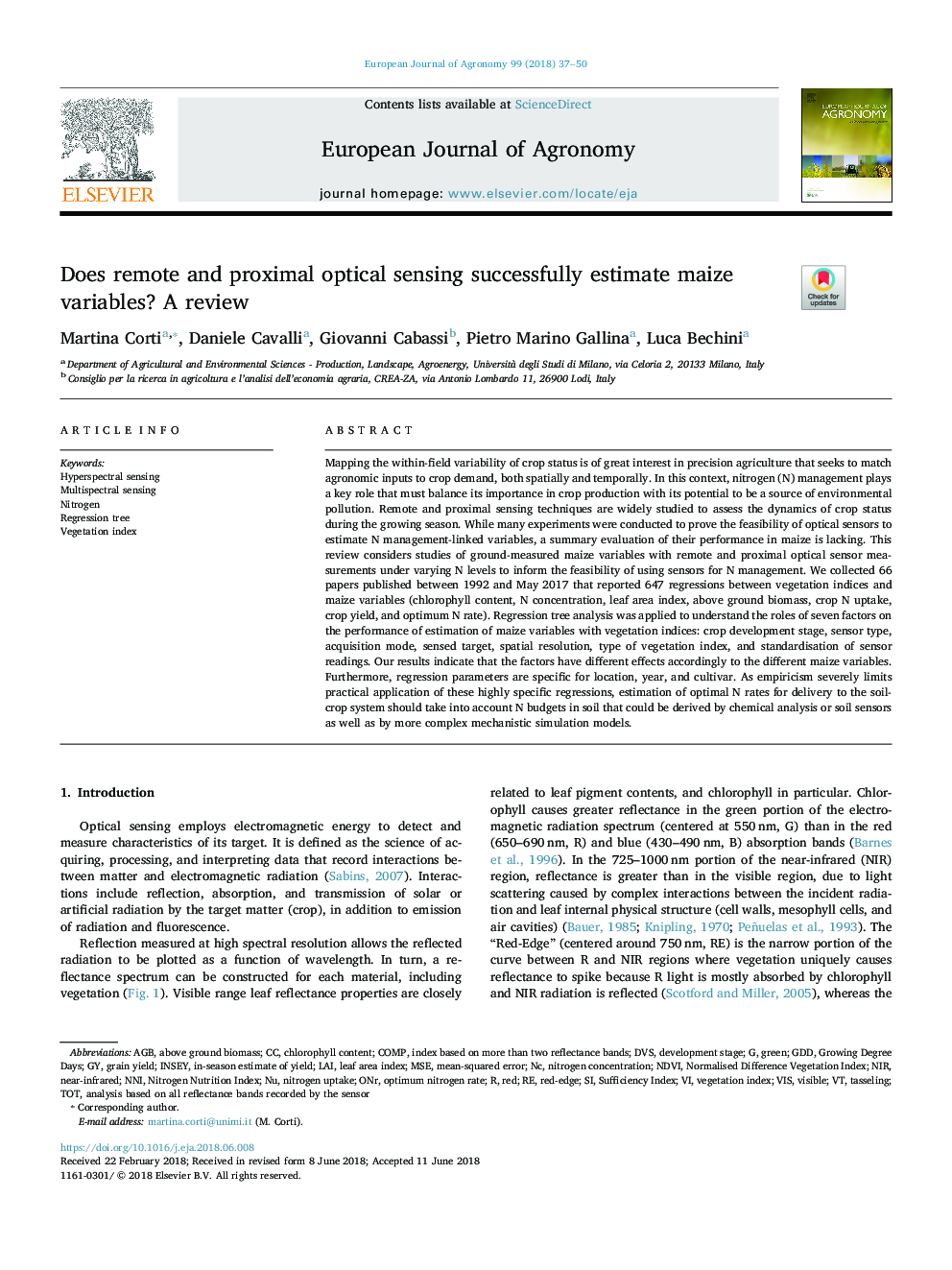| کد مقاله | کد نشریه | سال انتشار | مقاله انگلیسی | نسخه تمام متن |
|---|---|---|---|---|
| 8878817 | 1624425 | 2018 | 14 صفحه PDF | دانلود رایگان |
عنوان انگلیسی مقاله ISI
Does remote and proximal optical sensing successfully estimate maize variables? A review
ترجمه فارسی عنوان
آیا حسگرهای کنترل از راه دور و پروگزیمال به طور موفقیت آمیز متغیرهای ذرت را تخمین می زنند؟
دانلود مقاله + سفارش ترجمه
دانلود مقاله ISI انگلیسی
رایگان برای ایرانیان
کلمات کلیدی
ONRNIRDVSCOMPNNIGDDMSEVIs - VI هاtot - بهNitrogen uptake - جذب نیتروژنMean-squared error - خطای میانگین مربعاتRegression tree - درخت رگرسیونgrowing degree days - روزهای درجه رشدAbove ground biomass - زمین زیست توده زمینGreen - سبزRED - سرخNitrogen nutrition index - شاخص تغذیه نیتروژنLeaf area index - شاخص سطح برگNormalised Difference Vegetation Index - شاخص عادی گیاه شناسی تفاوتNDVI - شاخص نرمالشده تفاوت پوشش گیاهی Vegetation index - شاخص گیاهیLAI - شبیهAGB - شرایطGrain yield - عملکرد دانهNitrogen concentration - غلظت نیتروژنVisible - قابل رویتRed-edge - قرمز لبهChlorophyll content - محتوای کلروفیلdevelopment stage - مرحله توسعهNear-infrared - نزدیک مادون قرمزNitrogen - نیتروژن
موضوعات مرتبط
علوم زیستی و بیوفناوری
علوم کشاورزی و بیولوژیک
علوم زراعت و اصلاح نباتات
چکیده انگلیسی
Mapping the within-field variability of crop status is of great interest in precision agriculture that seeks to match agronomic inputs to crop demand, both spatially and temporally. In this context, nitrogen (N) management plays a key role that must balance its importance in crop production with its potential to be a source of environmental pollution. Remote and proximal sensing techniques are widely studied to assess the dynamics of crop status during the growing season. While many experiments were conducted to prove the feasibility of optical sensors to estimate N management-linked variables, a summary evaluation of their performance in maize is lacking. This review considers studies of ground-measured maize variables with remote and proximal optical sensor measurements under varying N levels to inform the feasibility of using sensors for N management. We collected 66 papers published between 1992 and May 2017 that reported 647 regressions between vegetation indices and maize variables (chlorophyll content, N concentration, leaf area index, above ground biomass, crop N uptake, crop yield, and optimum N rate). Regression tree analysis was applied to understand the roles of seven factors on the performance of estimation of maize variables with vegetation indices: crop development stage, sensor type, acquisition mode, sensed target, spatial resolution, type of vegetation index, and standardisation of sensor readings. Our results indicate that the factors have different effects accordingly to the different maize variables. Furthermore, regression parameters are specific for location, year, and cultivar. As empiricism severely limits practical application of these highly specific regressions, estimation of optimal N rates for delivery to the soil-crop system should take into account N budgets in soil that could be derived by chemical analysis or soil sensors as well as by more complex mechanistic simulation models.
ناشر
Database: Elsevier - ScienceDirect (ساینس دایرکت)
Journal: European Journal of Agronomy - Volume 99, September 2018, Pages 37-50
Journal: European Journal of Agronomy - Volume 99, September 2018, Pages 37-50
نویسندگان
Martina Corti, Daniele Cavalli, Giovanni Cabassi, Pietro Marino Gallina, Luca Bechini,
